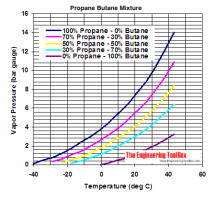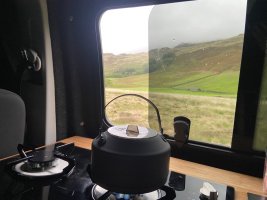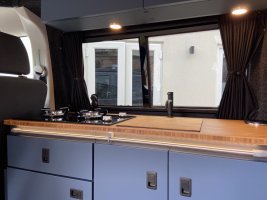You are using an out of date browser. It may not display this or other websites correctly.
You should upgrade or use an alternative browser.
You should upgrade or use an alternative browser.
Help needed with Thetford gas hob
- Thread starter michellecrown
- Start date
Here is one thought - the lpg that we get from pumps is a mixture of propane and butane, in colder weather the butane remains a liquid but the propane is still a gas ( that is why propane is better for winter use ) so the propane tends to get used first leaving the liquid butane behind which you then cannot use in winter.
( My boat had a butane cylinder for the stove and I could not use it in winter because of this and had to change it over to propane )
( My boat had a butane cylinder for the stove and I could not use it in winter because of this and had to change it over to propane )
michellecrown
Member
No gas is coming through now. We weren’t sure if it was the low temperatures impacting it as I know from wild camping the little stoves can sometimes become a problem at lower temperatures unless you get a different gas mix for extreme temperatures.
From day 1 it’s been a tricky hob to stay alight, and we have normally just held the knobs down longer and turned them until it stays lit.
From day 1 it’s been a tricky hob to stay alight, and we have normally just held the knobs down longer and turned them until it stays lit.
I have the same hob in my crafter and it never likes to stay on when set to full heat on lighting. Bizarrely though it runs at full heat afterwards. We were away at the weekend and the output was not as good as it usually is, we were around 0-1 degree both nights.
The vapour pressure certainly changes but I don't think you get one gas evaporating and the other not? Pressurised liquid gas turns to back to gas phase via evaporation not boiling, so it's a property of the mixture not the components.Here is one thought - the lpg that we get from pumps is a mixture of propane and butane, in colder weather the butane remains a liquid but the propane is still a gas ( that is why propane is better for winter use ) so the propane tends to get used first leaving the liquid butane behind which you then cannot use in winter.
( My boat had a butane cylinder for the stove and I could not use it in winter because of this and had to change it over to propane )
Propane Butane Mixture - Evaporation Pressure
Evaporation pressure of propane butane mixture vs. temperature.

But this is why butane is bad at low temperatures, evaporation cools the mixture (it's why sweating works) and if there isn't heat from the environment to keep it warm 100% butane (like the little cartridge stoves) will chill itself and pressure drop on even moderately cold days.
So I can see that an external tank in the cold could quickly drop pressure by chilling itself - and if you have a stove that is already on a knife edge pressure wise that may be enough to tip it over.
I don't know if in the UK the mix of LPG changes with season, I think in Scandinavia it does, so if you last filled up in the summer season you may have a more butane mix with lower vapour pressure.
It has been proven in the past that you can use up the propane in a mixture. Many years ago there was a study done with analysis. There was a table of the ratios for summer gas and winter gas that were used in the UK for road gas.
Catch 22 - the way to get the gas flowing again is to boil a kettle and pour the hot water over the tank.
Catch 22 - the way to get the gas flowing again is to boil a kettle and pour the hot water over the tank.
Yes. Dalton’s* law reminds us that the total pressure of a mixture of gasses is the sum of the partial pressures of the individual gasses.It has been proven in the past that you can use up the propane in a mixture. Many years ago there was a study done with analysis. There was a table of the ratios for summer gas and winter gas that were used in the UK for road gas.
Catch 22 - the way to get the gas flowing again is to boil a kettle and pour the hot water over the tank.
The components of the gas mixture behave independently according to their partial pressures, so yes, operating with a cold tank with a propane/butane mix will distill out more propane than butane. The gas mix will be richer in propane, and so slightly less energy per cm3 when you burn it. That might mean you have to leave it longer with the knob pressed in for the cutout to get hot enough. A simpler explanation might be it’s too cold to get enough pressure.
*Dalton of John Dalton Street in Manchester. 1766-1844
Thank you, there was a niggle that I'd missed something but refreshing my memory to double check I'd missed Dalton in searches.
Somewhere I have my father's old Optimus stove that has a brass petrol tank arranged so the heat of the burner (once you've lit it on meths) heats it and pressurised the tank. Which is an exciting arrangement and rather makes me thankful for readily available gas cartridges.
Somewhere I have my father's old Optimus stove that has a brass petrol tank arranged so the heat of the burner (once you've lit it on meths) heats it and pressurised the tank. Which is an exciting arrangement and rather makes me thankful for readily available gas cartridges.
I had one of these running on paraffin (I wouldn’t dare put petrol in), and it was an excellent stove, powerful, but also possible to turn it down. I had to solder a lever onto the bleed valve so I could operate when it was hot. It had a pump to initially prime with a leather washer, which had several improvised replacements.Thank you, there was a niggle that I'd missed something but refreshing my memory to double check I'd missed Dalton in searches.
Somewhere I have my father's old Optimus stove that has a brass petrol tank arranged so the heat of the burner (once you've lit it on meths) heats it and pressurised the tank. Which is an exciting arrangement and rather makes me thankful for readily available gas cartridges.
In the end it consumed itself in a fireball when it got far too hot, and melted the solder so I couldn’t turn it down.
Is that when a fat bloke with a bowler hat and a blackened face told you "That's another fine mess you've gotten me into, Stanley!"?In the end it consumed itself in a fireball when it got far too hot, and melted the solder so I couldn’t turn it down.
I used to have a Swedish petrol blowlamp, I only dared use it a couple of times before I went back to a paraffin one. They were great, you filled up the depression around the top of the tank with meths and put wood shavings or paper in and lit it. If you were lucky you had vapourized the paraffin in the tubes 1st time and you got a satisfying roar as you pumped up the pressure.
newbie here with new conversion so was trying off grid last weekend for the first time after successful campsite camping with no previous problems with the gas hob ever before and was looking forward to that all important first thing in the morning cuppa - when I turned on the gas hob I was awaiting the usual hiss of gas ( full tank by the way and yes the gas valve under the hob I had remembered to turn on ) but nothing happened -turned it off and tried again nothing - tried a couple more times same story - so I tried one last time suddenly I heard the gas hiss so pressed the ignition success ! So my question is why didn't the gas floe and hiss out straightaway like it has before , and why did I have to try so many times before it finally hissed the gas allowing me to light it ? Any idea's or help would be very helpful please
Was it very cold last weekend?
it was around 3 to 4 degrees
Could be a bit cold to get enough pressure up.
I think you could be right as it was fine yesterday on a much warmer day many thanksCould be a bit cold to get enough pressure up.
Similar threads
- Replies
- 6
- Views
- 810
- Replies
- 15
- Views
- 2K
- Replies
- 16
- Views
- 3K




